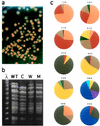Evolution of microbial diversity during prolonged starvation
- PMID: 10097156
- PMCID: PMC22413
- DOI: 10.1073/pnas.96.7.4023
Evolution of microbial diversity during prolonged starvation
Abstract
Models of evolutionary processes postulate that new alleles appear in populations through random spontaneous mutation. Alleles that confer a competitive advantage in particular environments are selected and populations can be taken over by individuals expressing these advantageous mutations. We have studied the evolutionary process by using Escherichia coli cultures incubated for prolonged periods of time in stationary phase. The populations of surviving cells were shown to be highly dynamic, even after many months of incubation. Evolution proceeded along different paths even when the initial conditions were identical. As cultures aged, the takeovers by fitter mutants were incomplete, resulting in the coexistence of multiple mutant forms and increased microbial diversity. Thus, the study of bacterial populations in stationary phase provides a model system for understanding the evolution of diversity in natural populations.
Figures




References
-
- Elena S E, Lenski R E. Evolution. 1997;51:1058–1067. - PubMed
-
- Dykhuizen D E. Annu Rev Ecol Syst. 1990;21:373–398.
Publication types
MeSH terms
Substances
Grants and funding
LinkOut - more resources
Full Text Sources
Research Materials

